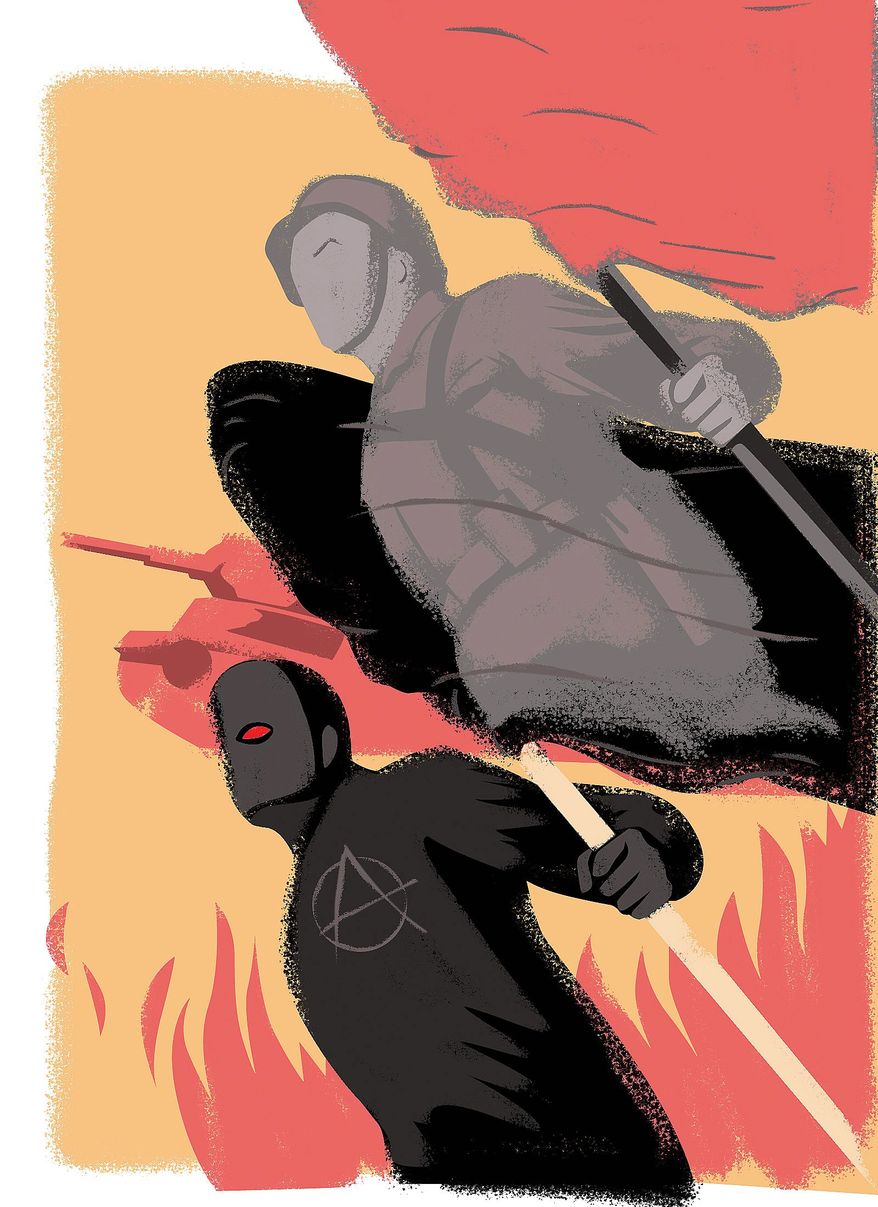Old hatreds made new
The 'Antifa' gets a media assist to hide its totalitarian roots

Amid the chaos of Charlottesville, two specters from the previous century’s darkest hours have re-emerged. Alongside the well-publicized Nazi symbols on full display during the “Unite the Right” rally, so too were Communist hammers and sickles brandished by the opposing anti-fascist or “Antifa” protesters. Many have rightfully condemned the neo-Nazis and their Ku Klux Klan allies leading Riefenstahl-esque, torchlit processions through our streets, but there has been virtual silence about the neo-Marxists and anarchist comrades hurling bricks and incendiary bombs, all the while refusing to acknowledge communism’s long record of totalitarianism, racism and death.
Lining up against one another in public, clubs and bats in hand, those on the far right and the far left are horrifying replications of our nation’s greatest historical foes. At their respective beginnings in the 1910s and 1930s, both the communists in Russia and the national socialists in Germany comprised tiny minority factions in their countries. But they became the loudest, the best organized and the most violent.
Indeed, 78 years ago this week, Adolf Hitler’s Third Reich and Joseph Stalin’s USSR co-launched World War II by signing a nonaggression pact. Negotiated by Soviet Foreign Minister Vyacheslav Molotov and German Foreign Minister Joachim von Ribbentrop, their regimes agreed to conquer Europe by dividing it in half. Fascism and communism ignited a conflict that would consume millions of lives by marching shoulder-to-shoulder into battle.
Within days of signing the Molotov-Ribbentrop Pact, Hitler’s armies invaded Poland. Over the next several months, Stalin invaded Finland, Estonia, Latvia, Lithuania, Romania and the other half of beleaguered Poland. For nearly two years, the Nazi SS and Soviet NKVD (predecessor to the equally-dreaded KGB) intimately collaborated. Soviet secret police, for instance, rounded up German Jews who had escaped to the Soviet Union and handed them over to the SS.
Then in 1941, Hitler broke the pact and attacked the Soviet Union. When the war ended, the Nazi regime was finished, but the Soviet empire lived on — sustained by its domination of Eastern Europe. Partisans in the Baltic forests who had fought occupying Nazi forces promptly repositioned their rifles toward the Red Army. And pro-fascist collaborators slotted seamlessly into the Eastern Bloc’s nascent state security apparatuses.
Even as late as the 1980s, most in the West expected that the Soviet Union — despite its obvious weaknesses — would persist indefinitely. However, refugees from Lithuania, Estonia, Latvia, Poland and other “captive nations” began organizing protests on Aug. 23, the anniversary of the Molotov-Ribbentrop Pact, calling it “Black Ribbon Day.” They stressed to the world that Stalin — who was made over by fellow travelers in the West as “Uncle Joe” — was actually an enemy of peace in World War II. They further urged Americans to oppose the Soviet Union, which still controlled much of Central and Eastern Europe.
On Aug. 23, 1989, in the midst of revolutions throughout the Soviet empire, approximately 2 million people joined hands in a human chain that stretched over 370 miles across Estonia, Latvia and Lithuania to protest communist influence. The event, known as the Baltic Way, was a powerful symbol of peaceful popular resistance to totalitarianism. A little over two years later, on Sept. 6, 1991, the Baltic states reclaimed their independence, and on Dec. 25, 1991, the Soviet Union finally ceased to exist.
Unfortunately, over the past two decades, the evils of Soviet communism and Stalin’s critical role in the Axis have been largely forgotten. Within Russia, Stalin is increasingly viewed as a national hero, an opinion that has grown along with the size of Russia’s Communist Party in the Duma, and has been additionally fostered by Vladimir Putin’s own party, United Russia.
Black Ribbon Day remains important because it lays bare the fact that fascists and communists continue to use the same tactics to demonize, isolate and crush their adversaries. Historical amnesia, grievance culture and political violence make for a toxic cocktail. It is the responsibility of every American to study the past — to seriously study it — and to grasp what is necessary to guarantee “liberty and justice for all.”
The dearth of basic historical education in public schools — combined with the substitution of civics for divisive identity politics — has bred cynicism, turning the millennial generation cynical and away from the democratic project. This explains, in part, why those under the age of 30 are far more likely to engage in protests than to vote, participating in peaceful revolutions, as our country’s Founders had wished, at the ballot box. For this reason, it is critical to remember that Nazism and Soviet communism are two sides of the same totalitarian coin.
Marion Smith is executive director of the Victims of Communism Memorial Foundation.

